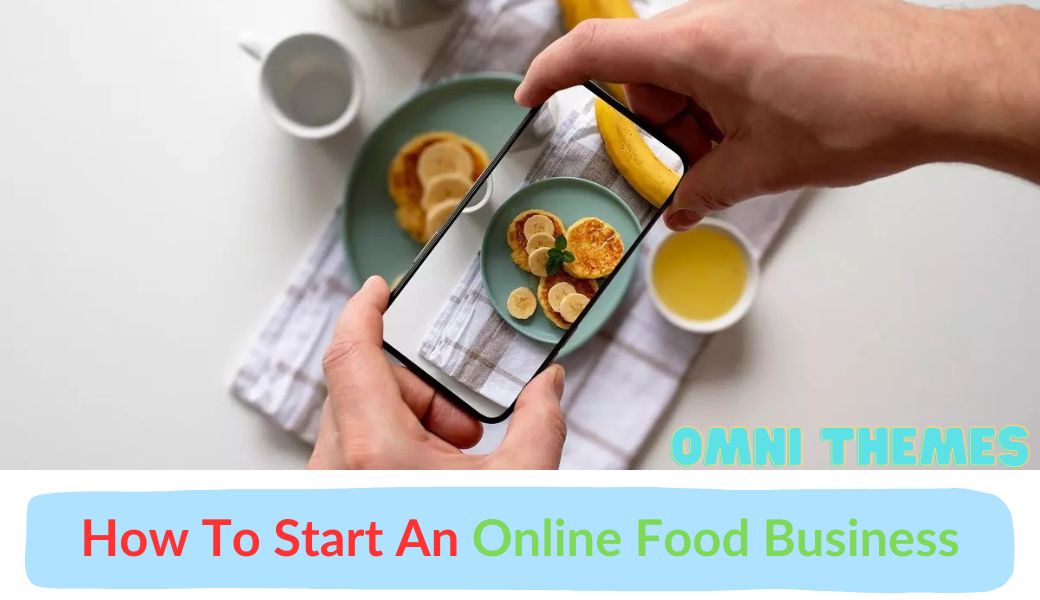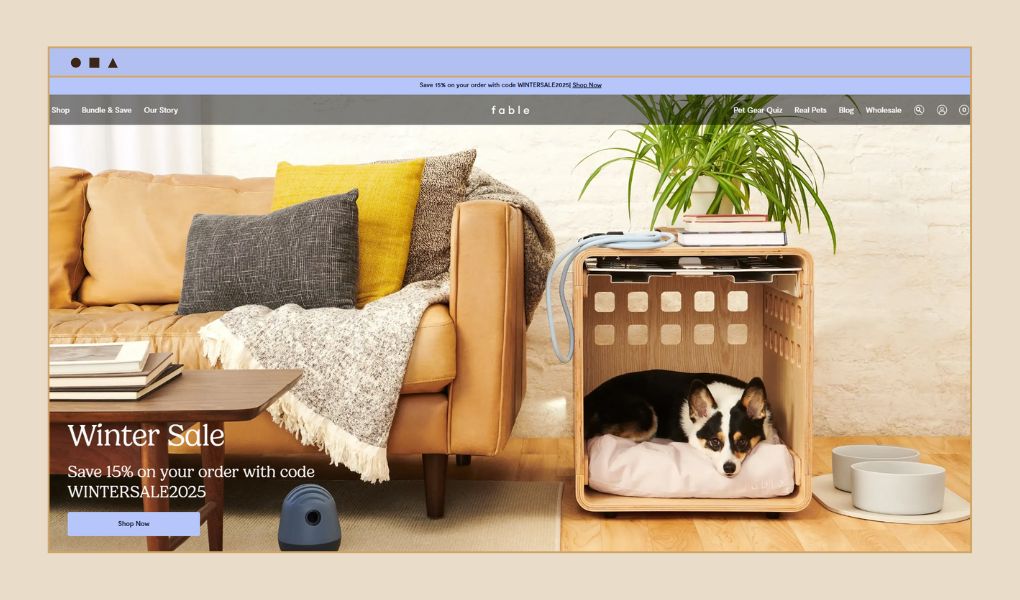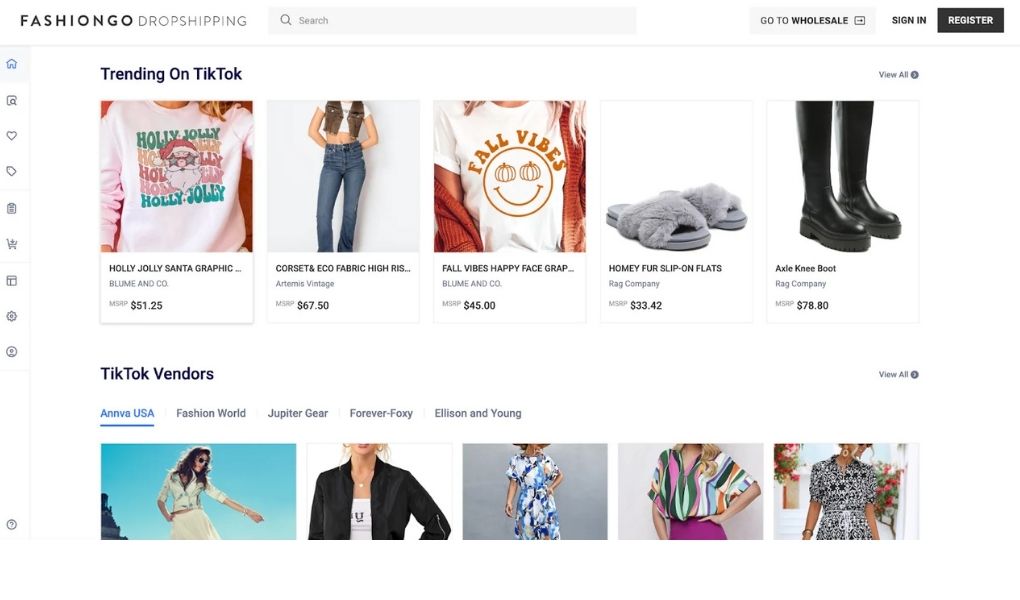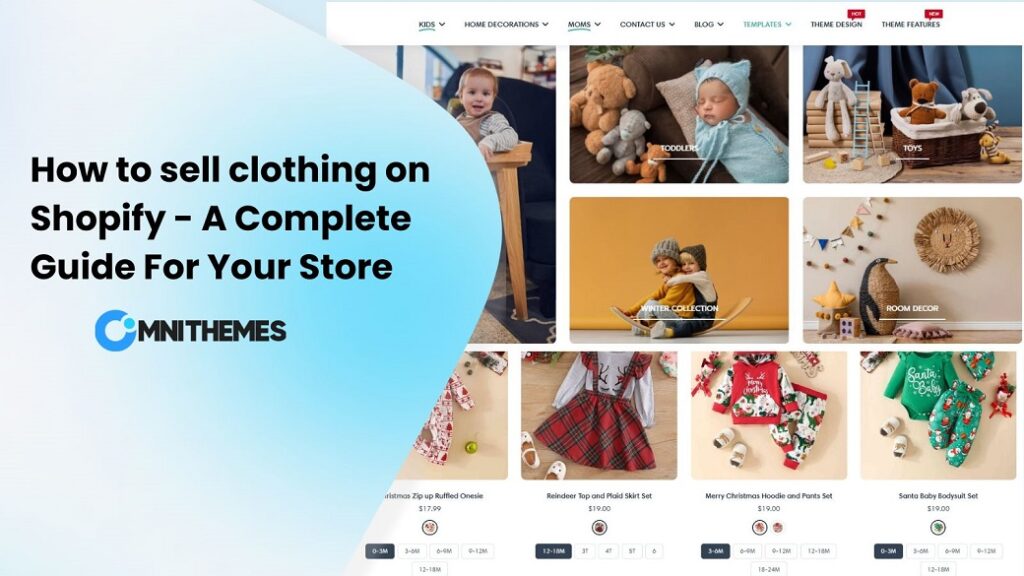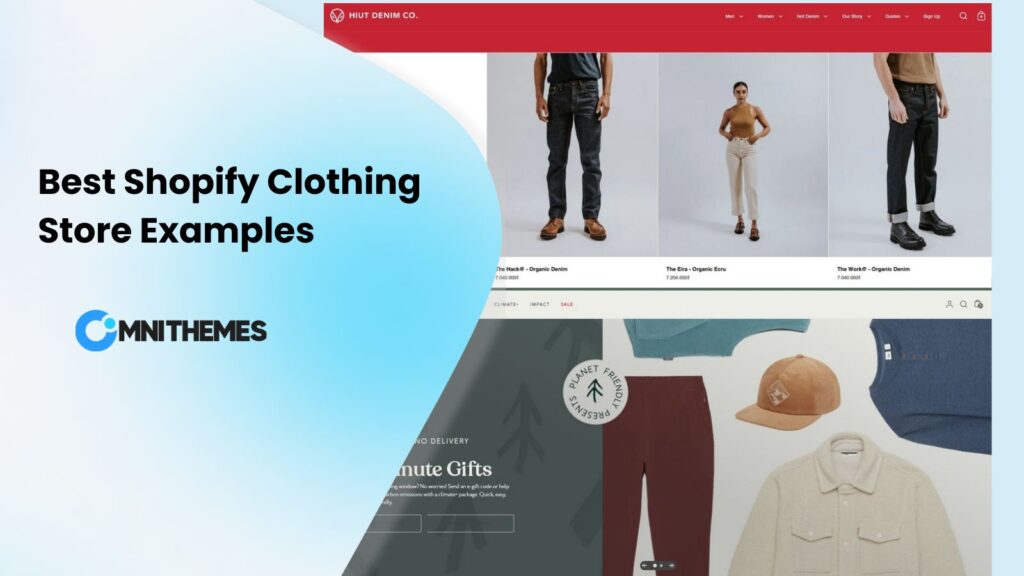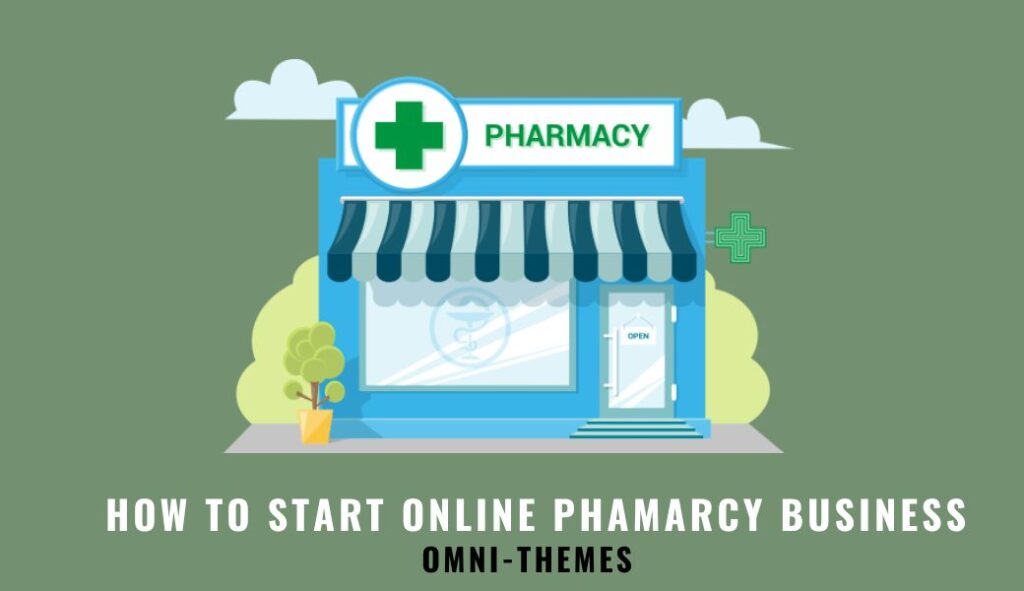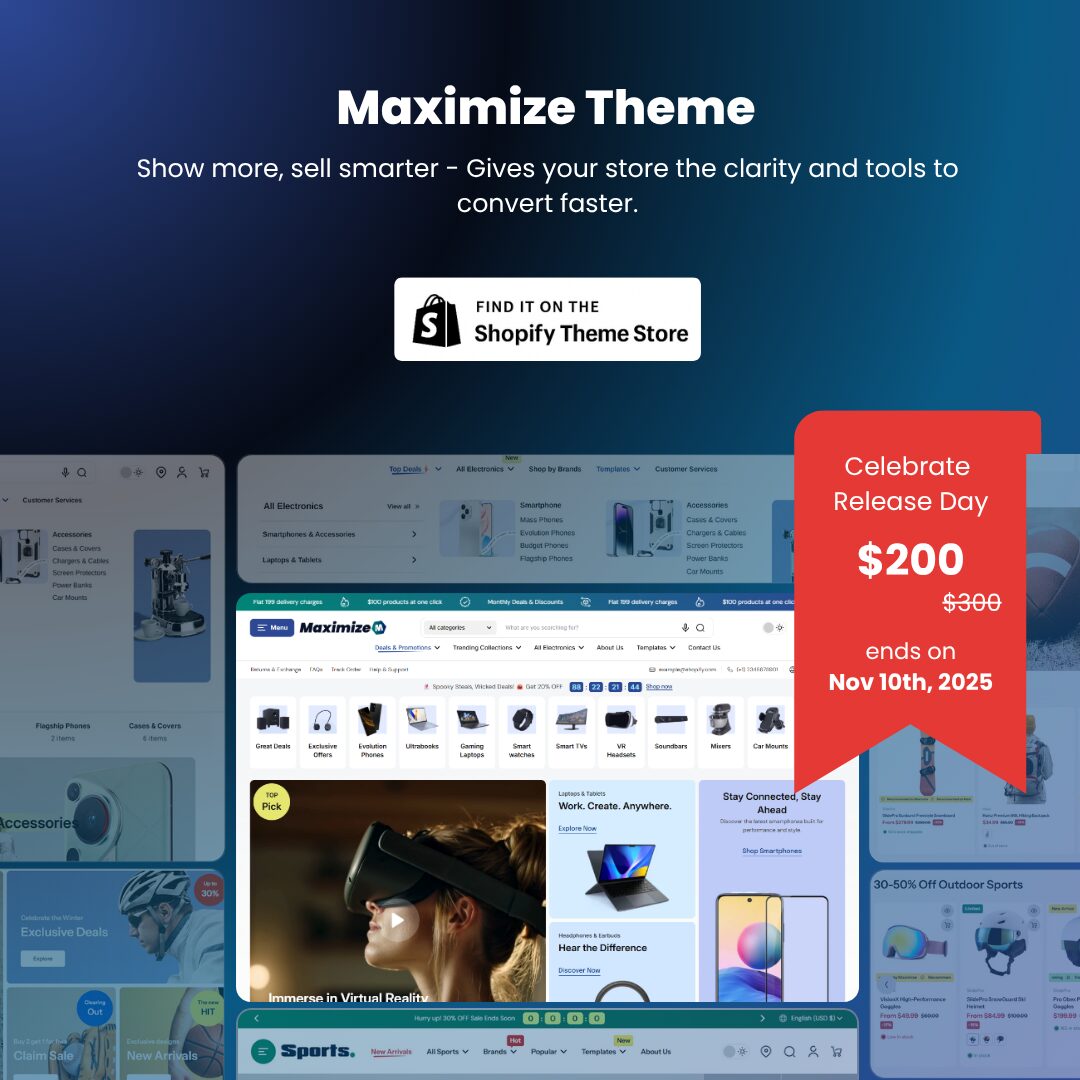Beginners often find the online food sector intimidating, especially if they are unfamiliar with it. There are several elements to consider while learning how to sell food online, including manufacturing and packaging, efficient marketing, attention to quality, customer feedback, and food regulations and company permissions.
In this post, we will give ideas and specific procedures to assist you in getting from conception to a successful online food business. Whether you’re just getting started or seeking to expand your food company online, you’ll find the steps you need, from preparation to infrastructure setup, developing an online presence, and marketing.
By the conclusion of this article, you’ll be prepared to launch an online food store and understand how to scale it to success.
Detailed guide on how to start an online food business
We will demonstrate the detailed steps how to start an online food business:
Find your online niche
To generate a company concept in the food market, choose a specific target demographic and study their demands. Create online polls, question friends and relatives who belong to your target demographic, and search internet forums to determine what they might require.
Once you’ve decided on a certain emphasis, use Google Trends to determine its profitability. Research keywords relating to your niche, then look for goods that are frequently popular. This will guarantee that there is a demand for the segment you plan to enter.

If you’ve chosen to start an online food business, these are some types of products you can sell online right now:
- Desserts: You may offer a wide range of sweets online and make custom boxes and combos for various events (birthdays, anniversaries, business get-togethers, etc.).
- Meal kits: Meal kits became extremely popular during the pandemic when people were unable to go out to eat and preferred to prepare at home using restaurant-quality supplies.
- Traditional handmade meals: With so many other restaurants serving pizza, burgers, and other quick food, you may stand out by selling handmade dishes such as potpie, meatloaf, stew, and so on. Consider serving online foods in large amounts, such as a complete pot of stew, to accommodate the entire family.
- Online food Catering: If you cater to workplaces and businesses or events like weddings and bachelorette parties, you have a large customer base that will return to you for their next event if you wow them with your wonderful food.
- Lunch boxes: If you’re thinking of starting an internet food business near an office park, it’s a pity not to appeal to the lunch crowd. Many folks will likely order delivery because they do not have time to go out for lunch. If you can provide them with tempting lunch specials and combination deals, they will make your business their first choice.
>>> Get inspired and learn from 7+ Shopify store design inspiration
Investigate food laws & policies
Although an online food company requires fewer licenses and approvals than a physical establishment, you must still deal with a number of legal difficulties. You will require a business license, a food license, a food handler’s permission, a food establishment permit, and additional permits and licenses, depending on your area.
If you want to cook the food at home, you must follow your state’s cottage food regulations, which guarantee that the food you prepare follows local health requirements. To sell food online under a name other than your own (such as a brand name), you must first obtain a Doing Business As certificate (which is less costly) or form a Limited Liability Company.

If your product is difficult or requires additional licenses (such as meat, seafood, or some agricultural items), you should see a food industry lawyer. Though the initial investment may be pricey for a new business owner, it may save them from far more costly repercussions in the future.
These licenses are available for purchase in your local areas. Your area municipal corporation may provide you with all of the information you need on this procedure. It may seem like an unnecessary cost at first, but it will pay off in the long term and save you a lot of hassles as your business expands.
Choose the business online model
When beginning an online food business, one critical step is to identify the production model that will be utilized to make and distribute your items. There are various choices to consider, including self-production (selling handmade food), manufacturing, and resale. Each model has advantages and disadvantages, and it is critical to determine which one is ideal for your organization.
If you want to sell food online, there are two basic business models to consider right now. We will present them below:
Produce and sell products online yourself
You have the option of managing the entire supply chain and being personally involved in manufacturing, or you can deal with a third-party manufacturer who will develop and package a formula to your requirements. In this approach, you can also broaden your sales channels and explore wholesaling to other stores.
Many places have cottage food regulations, which enable you to create some food items in your home kitchen without having to satisfy the same standards as a commercial kitchen. In the United States, make sure to research each state’s cottage food rules, as they vary by location.
Import, manage, and resell products online
This online food business model entails reselling by curating other companies’ items under your own label. Your unique selling point (USP) may be that your store offers the best of a specific product category (say, mustards from around the world) in a single shopping experience. Otherwise, you may use dropshipping to introduce another brand’s items to a new market.
Build your online brand
After you’ve finished the tasks of finding a suitable niche, checking the regulations, and choosing the business model, the next stage in starting an online food business is to develop a brand that will help you stand out in the market and attract clients. This procedure involves several critical steps, including naming, designing a logo, selecting colors, and developing packaging.
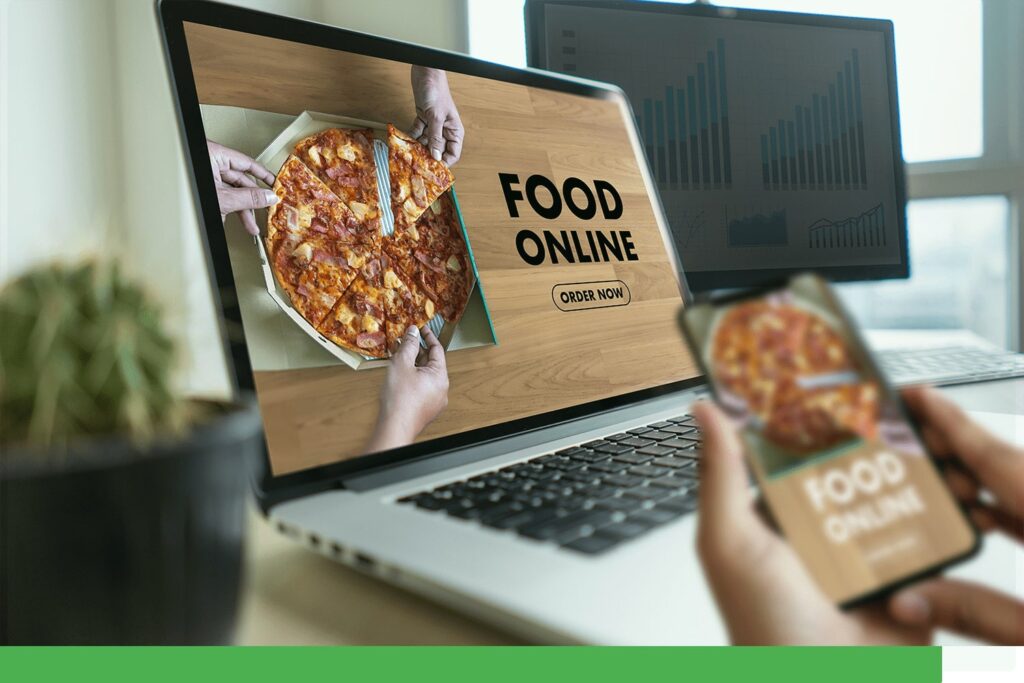
Come up with a brand name
The name of your online food brand is one of the most crucial parts of your business. You should come up with a name that is easy to remember, spell, or pronounce so that clients can approach it with ease. It should also be unique and not already used by someone else. The name should also reflect your brand’s personality and the things it provides. It is critical to undertake comprehensive research to see whether the name is accessible as a social media handle or a trademark.
Get a good online domain
When users visit a website, they input its domain name into their web browser. Because your consumers will be using it, it is critical that you select a domain name that accurately portrays your organization. Make sure it’s original, relevant to the online food categories you sell, and simple to remember. Keep things simple and basic. To avoid confusion, do not use hyphens or digits.
You should also claim nearby alternatives to your domain to increase site traffic. Use a domain checker to validate the availability of the desired domain name, and then register it. Check out prominent social networks as well, so you may use the same name on numerous sites.
Design a unique logo
The logo is the graphic representation of your online food brand. It should be straightforward, memorable, and easy to identify. It should also be adaptable enough to be utilized in a variety of contexts and formats. A good logo should be able to convey the essence of your brand in a straightforward and effective manner. It should also be developed so that it can be utilized in a variety of sizes and settings.
Choose the main colors
The main branding colors you use for your brand may have a significant influence on how your clients perceive it. They must be consistent with the overall design and able to elicit the emotions and sensations that you want your customers to connect with your brand. It is critical to investigate color psychology and select colors that are consistent with your brand’s message and values.
Choose the type of online store you want to build
We propose three common systems for launching an online store: WordPress, a website builder, and an eCommerce platform.
An eCommerce Platform (highly recommended)
An eCommerce platform is primarily used to create and manage online stores. Most include comprehensive built-in tools for managing products and orders. There are two kinds of eCommerce platforms: hosted and self-hosted. The term “hosted” refers to a platform that includes hosting services, whereas “self-hosted” indicates you must select your own web host.
Some of the most popular eCommerce platforms to consider include Shopify, Wix, Webflow, Squarespace, etc.
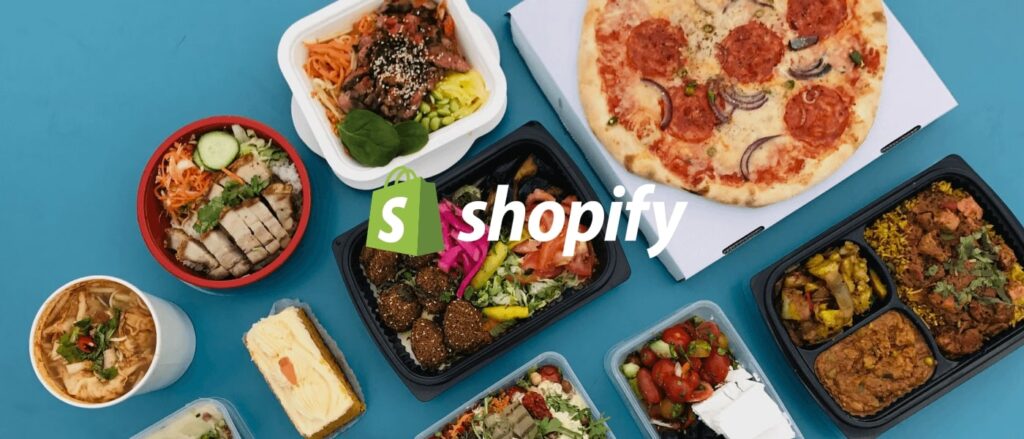
A Website Builder
Website builders make it easy for beginners to construct and publish their own websites. Most of them include simple drag-and-drop editors that allow you to add content and change current themes. There are various food/restaurant website builders on the market, and Hostinger Website Builder is one of the most economical.
WordPress
WordPress is a content management system that enables users/ individuals to create and manage an online website/ store with ease. Its versatility enables you to install any theme and tweak it to match your business, or you can purchase ready-made themes from third-party vendors.
Customize your online store
Here, we will assume that you select the Shopify eCommerce platform to build your own online food business. Now that you’ve decided on a platform let’s go over the processes for creating and setting up your own online food store to sell your items. In the steps below, we will demonstrate how simple and quick you may complete this level.
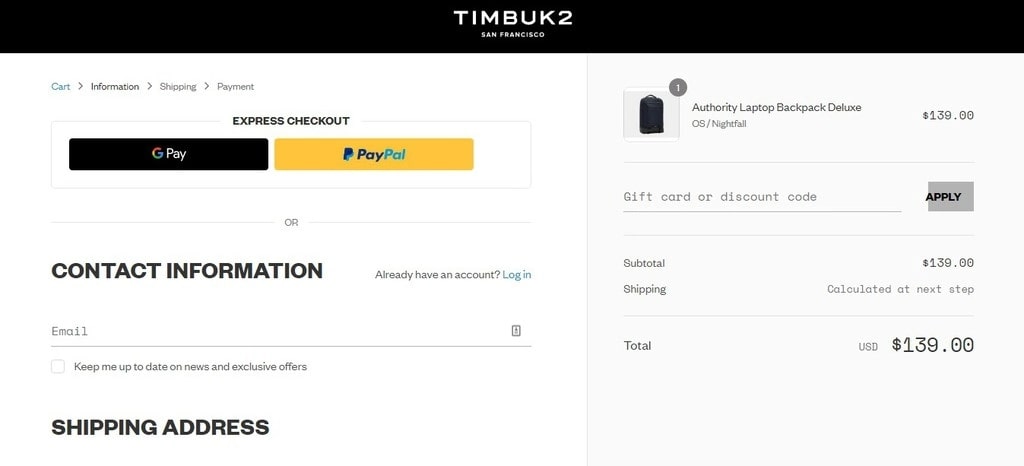
Choose a theme
Choosing a theme/ template for your online food website is a crucial step in determining the overall design and layout. It’s very important to choose a theme or template that is visually appealing and consistent with your brand.
If you use an eCommerce platform like Shopify, you choose an eCommerce theme from the available selection (like Eurus Shopify theme). To save time, browse any themes that interest you and choose ones that will not require substantial alterations or customization to fit your brand.
After you’ve chosen a template, change the design to suit your needs and preferences. Change the fonts and colors, replace the header picture, and alter the layout. Furthermore, you may design your eCommerce site to reflect your brand while keeping client demands in mind. Make sure it’s easy to browse, well-organized, and responsive.
Add necessary pages
Below are some of the most basic pages that every online store should have, including your future online food store:
- Homepage: The homepage is the first page that potential clients will view while searching for your website. Make sure it’s uncluttered, easy to browse, and reflects your brand.
- Product page: The product page is where you present all of the items and services you have to offer to clients.
- About Us page: This page should tell the story of your brand’s origins, values, and beliefs, as well as what makes it special.
- Contact page: Please provide your phone number, email address, and physical address. Make it easy for consumers to contact you by including a contact form.
- Frequently Asked Questions (FAQ) page: This page answers common queries from customers, such as shipping information, postage rates, and product specifications.
Set up product pages
Product pages are the core of your online store since they are where you decide the conversion rate of your online food business. It is where clients will learn about what you sell and decide whether to buy something or leave the website completely.
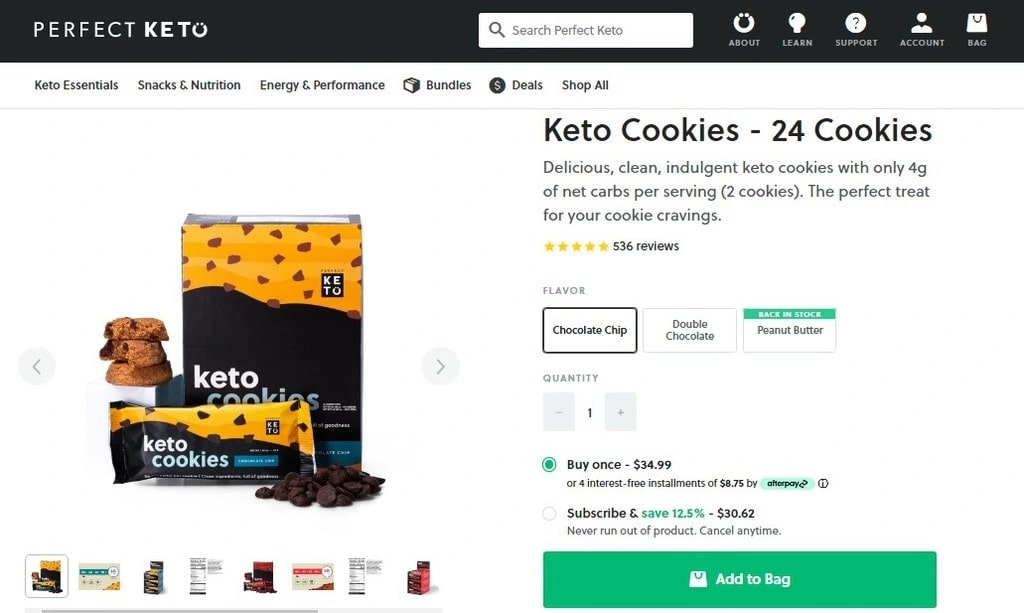
High-converting product pages have high-quality images, thorough descriptions, call-to-action (CTA) buttons, and clear price and shipping information. If a product has more than one variation, do not create several listings. Upload them to a single page so clients may simply locate what they’re searching for.
Set up payment gateways
To enable customers to make purchases, you need to set up secure payment methods in your online store. The setup process should include adding online payments that you want to introduce to clients (you should use the popular payment gateways in this case).
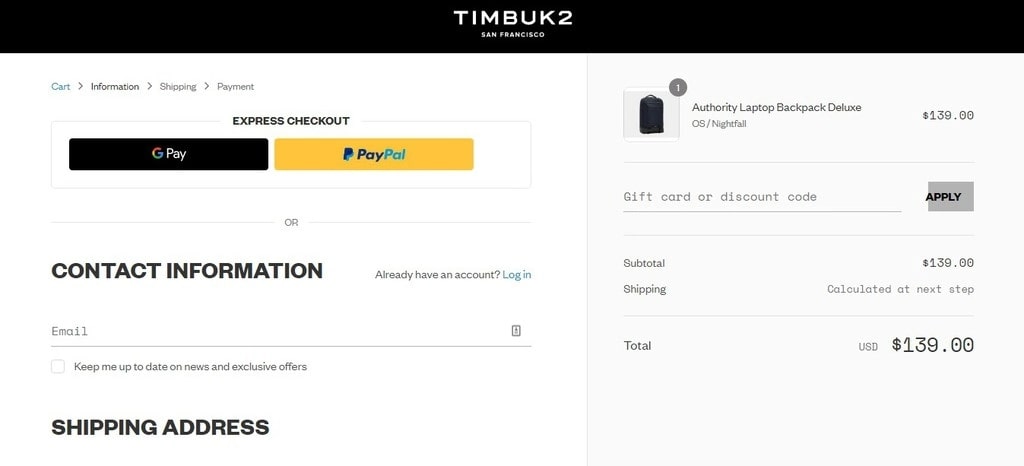
Having a functional online store is essential for the success of one’s own food business. By putting thought into each of these elements, you can create an online store that is easy to use and that helps you reach customers and generate sales.
Popular payment options include payment gateways like PayPal and Stripe. If feasible, offer express checkout through these gateways so that consumers do not have to provide their payment and shipping information.
Set the price for your online products
As soon as you finish the customization for your online store, it’s time to decide on the prices for every product available in that store.
There is no standardized method for pricing online food items. The only method to get your pricing correct is to assess the cost per item by factoring in ingredient prices, production expenses, labor costs, and manufacturing overhead. In general, a margin of 10% is regarded as typical, while 20% is considered large. However, the appropriate net profit margin differs by industry.
Alternatively, investigate your competitors and compare their prices. It’s best to stick to a comparable pricing range, which may assist you in spreading the word and developing your brand presence. Ultimately, there is no single price formula that will work for everyone. You should properly grasp your expenses (both fixed and variable) and make adjustments until you get it correct.
Scan the source of ingredients/ suppliers
Once you’ve decided on the exact product prices for your online food business, the following step is to discover ingredient suppliers that can deliver the raw components you need to make your goods.
Once you’ve chosen a few suppliers, investigate their credibility by tracking the supply chain and requesting certificates. Alternatively, interact with individuals in your sector to obtain reliable information about the providers with whom you can engage.
There are various choices to consider, including food shops, local providers, and warehouses. Each choice has pros and downsides, and it is crucial to assess which one is the greatest match for your organization.
- Grocery store
Purchasing ingredients from a grocery store can be a practical alternative for small enterprises or home-based entrepreneurs since it provides simple access to a diverse range of items. However, it may be more expensive than other solutions and provide less quality or consistency than a specialist source.
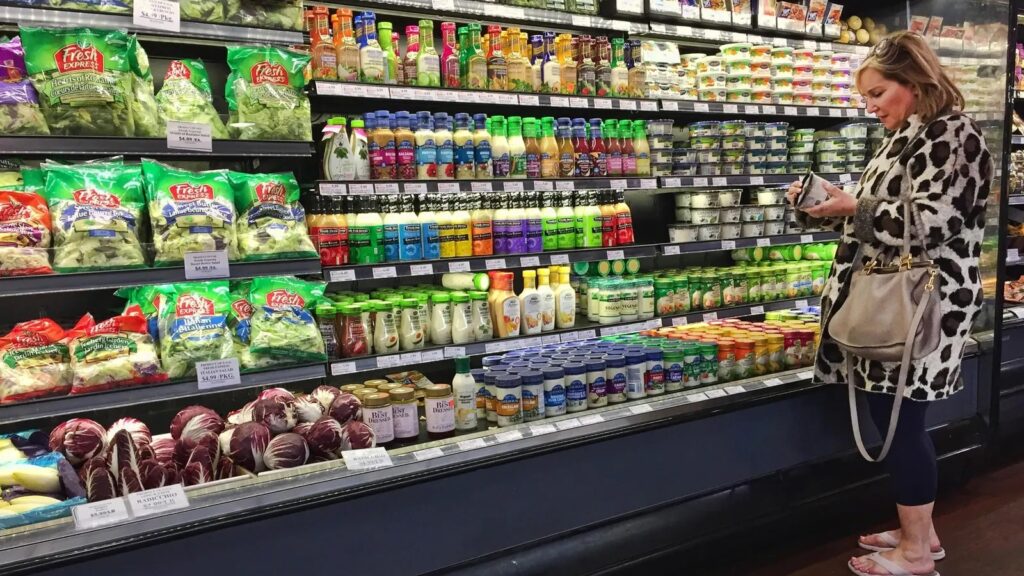
- Local supplier
Purchasing food materials from a local provider is an excellent choice for businesses looking to support the local economy while also ensuring that their ingredients are fresh and of high quality. Local suppliers may be more adaptable and eager to collaborate with small firms. However, local providers may have fewer options and higher pricing.
- Warehouse
Purchasing supplies from a warehouse may be a cost-effective solution for organizations that require large amounts of components. Warehouses sometimes provide lower pricing than other choices, but they may not provide the same quality or freshness as a local source.
When choosing an online ingredient provider, it is critical to thoroughly consider all possibilities and their relative benefits and drawbacks before making a decision. Whether it’s a grocery shop, a local supplier, or a warehouse, consider all of the aspects that may influence your selection. Before making your final decision, make sure to undertake thorough study.
Set up online delivery/ shipping activities
Shipping and delivery are crucial aspects of any online food business. By considering each of these factors, you can develop a shipping plan that guarantees that your clients’ goods arrive on time and that you can manage your shipping and delivery demands efficiently.
Place different delivery zones
To guarantee that your clients’ products arrive on schedule, you must establish distinct delivery zones for your firm. This involves establishing the locations to which you can actually deliver, as well as any additional expenses connected with deliveries outside of those zones. Setting distinct delivery zones ensures that your consumers know when to anticipate their products and avoids uncertainty.
Delivery or Pickup
As an online food business, you must determine whether to provide pickup or delivery services, or both. The pickup service is less expensive, but the delivery service offers more convenience to clients. Consider your target market’s preferences while making this selection.
Self-delivery or external shipping service
Business merchants can decide whether to handle deliveries in-house or outsource them to an external courier service. Self-delivery allows you to have more control over the delivery process and create client connections, but it is also more time-consuming and expensive. External courier services may be more efficient, but they are also more costly and less personalized.
Packaging and Labeling
Besides shipping activities, packaging and labeling are also very important since this can ensure the quality of online food products when they come to customers’ hands.
Your packaging design should also be designed with ease of opening, closing, and storage. It is critical to evaluate the packing materials and their environmental impact. It is critical to employ authorized materials that promote food safety.
Also, you must have an appealing packaging design to attract new clients because they cannot taste the food you are serving before opening the boxes/ orders. Because of its importance, consider employing a professional designer to build the packaging for you. They can help you choose a color palette, typeface, shape, and material that will work together to create beautiful and practical packaging.
In addition, you should examine your region’s packaging and labeling requirements. The Nutrition Labeling and Education Act of the Food and Drug Administration requires that most foods be properly labeled. It should include ingredient information, nutritional claims, and health messaging.
Implement online marketing plans
Online marketing is one of the most crucial components of operating an online food business. It will be one of the most difficult learning curves for novice entrepreneurs when launching a food business on the internet marketplace. When selling food online, it is critical to connect with your clients through your story. If people can’t taste your cuisine, you need to appeal to their other senses.
Below are some of the most effective marketing methods to help you promote your online food business:
- Social Media Marketing:
Social media marketing is an effective way to reach customers and promote your online food business. Social media platforms like Facebook, Instagram, and Twitter may help you engage with customers, exchange product information, and establish a community around your company. It is critical to select platforms that are most relevant to your target market and maintain a consistent and engaging presence.

- Offline Marketing:
Offline marketing methods may also be an efficient approach to reaching out to clients and promoting your food business through an online marketplace. It covers techniques like fliers, pamphlets, and business cards. It’s critical to use strategies that are most relevant to your target audience and to ensure that your marketing materials are consistent with your brand.
- Paid advertising:
Paid advertising is a simple and effective approach to contacting clients and marketing your online food business. Platforms like Google Ads and Facebook Ads may help you target particular audiences and market your products and services. However, you should be aware that this sort of advertising is one of the most expensive. If you’re just getting started, consider different marketing strategies first before paying money to invest in this approach.
Eurus theme | The surface of your online food business
Without a doubt, Shopify can help many shops succeed in the online food market. It’s a platform that allows anybody to effortlessly manage and launch an online food business. Eurus, the premium Shopify theme created by BSS Commerce professionals, is a standout in the Shopify collection.
The Eurus theme is one of the greatest options for effectively beginning an online food company since it prioritizes efficiency and ease of modification, making it simple to manage your online food collection.
Customers may inspect food attributes such as page quality and coverings using capabilities such as high-resolution zoom. Additionally, you may add many images to highlight different aspects of each food item, making browsing more enjoyable.

Let’s investigate some key features of the Eurus theme that can support you in building a stunning online food business:
Main features
- Smart suggestions:
Provides AI-powered suggestions to propose the best online foods/ meals for each consumer. Analyzes surfing history, purchase history, and keyword data to suggest comparable food products to clients.
- Customize design:
Eurus enables you to customize the store’s appearance and feel to reflect your food brand identity, allowing you to build a specific genre focus or create a curated, friendly environment for food enthusiasts. It also provides a responsive design, guaranteeing that your online food business looks fantastic and performs well on any platform, from PCs to mobile phones.
- Marketing/ Conversion tools:
You can make use of Eurus’s integrated tools for marketing activities, including pop-ups, promotions, and product badges. These may be used to promote recently launched goods or to provide online food discounts, both of which can boost sales and customer engagement in your virtual food store.
- Product Description:
Business merchants can upload amazing, high-resolution images of your food or drink and use the zoom feature. Customers may receive a close-up look at the specifics of your food goods, increasing trust and confidence in their purchases.
- Re-order:
This function allows customers to re-order the exact previous orders from your store to save time when purchasing the same food items.
- Estimated delivery date:
With food items, the delivery date is crucial since we want to make sure they are of the best quality when coming to customers’ hands. This function announces to clients the estimated date that they can receive their orders and helps them prepare in advance.
- Product Bundle:
Customers can utilize this feature to purchase similar food items in bundles to save time and money effectively.
Related post
How To Sell Clothing On Shopify – A Complete Guide For Your Store
To sum up
The online food industry is constantly open to new firms. With rising competition and client demand, it’s a smart idea to go into eCommerce and learn how to sell online. Follow the procedures that we outlined above to establish and develop your online food business smoothly. With the appropriate information and hard effort, you can start a thriving food business in no time.
If you have any other questions or recommendations, please leave a comment down below at Omnithemes.com

